Abstract
This work presents a methodology for obtaining a quantitative expression of the superficial deterioration of bricks affected by climatic conditions. The method combines in situ measurements with laboratory data. Input data on material recession were obtained from photogrammetric observations, the material properties were derived from laboratory tests or the relevant literature, and climate data were provided from regional environmental monitoring service. The climatic parameters considered in this study are: relative humidity, number of freeze-thaw cycles (i.e., mean number of days per year with temperatures below zero), and peak sun hours per day. The methodology proposed estimates the deterioration rate of brick façades under variable climate conditions over time. As a conclusion of this research, a new tool for the structural evaluation of brick walls is presented.
1. Introduction
The deterioration of heritage constructions is a problem for modern societies [1]. Different materials have different types of environmental and climate vulnerabilities, and these vulnerabilities determine the prevalence of mechanical or chemical weathering in different climate conditions. Water content is known to be a key factor in stone deterioration [2,3]. Water significantly affects material behavior and can cause structural damage. Indeed, deterioration caused by water (moisture and/or rain) can be due to several causes, such as chemical dissolution [4] or mechanical actions associated with changes in volume when temperatures drop below zero degrees (freezing–thawing). However, different materials have different compositions and textures that also affect the deterioration rate. Numerous damage functions are presented in the literature, especially for carbonate rocks [5], and they have been used to produce European-wide maps showing stone recession as an effect of cumulative damage processes in different climate change scenarios [6,7]. More recently, vulnerability maps, based on hazards and the magnitude and frequency of extreme events related to climate change, have been proposed to support the safeguarding and risk management of cultural heritage [8,9,10,11].
It has been observed that the aging of heritage buildings is mainly manifested on exterior façades, which are those that are exposed to environmental stressors. These façades can present different levels of aesthetic deterioration in addition to reducing the structural capacity of the building. Evidence shows that, in most cases, the parts of the buildings closest to the ground are most affected by deterioration since construction materials (stones, mortars, bricks) are porous and allow water to rise through capillary action [12].
Empirical descriptions of recession pattern rates, based on photogrammetric observation, have recently been proposed for the case of San Jerónimo monastery in Granada [13]. Nevertheless, this study does not consider the potential variability of the climate conditions for the monastery.
The study presented in this paper connects climate conditions and the evolution of the deterioration of a brick façade. The study has been applied to a historical building in Venice (Italy), Santa Maria dei Servi church (14th and 15th centuries). In this case, the main building material is brick, which is widely used in Venice, which is particularly vulnerable to salt crystallization. The two sides of the same façade (western and eastern sides) are studied.
2. Materials and Methods
The first assumption consists of considering that the recession of a brick façade is linear with time, for constant climatic conditions. Additionally, a parameter called the Unified Climatic Parameter (UCP) is defined. The UCP, defined in Equation (1), is specific for each type of building material, and, for the sake of simplicity, it is formulated as a linear combination of the climatic parameters (cpi) affecting recession, as shown in Figure 1.
with ai as the weighting coefficients of the climatic parameters (cpi) considered; see Figure 1. Therefore, the interaction phenomena between the different climatic parameters are not considered.
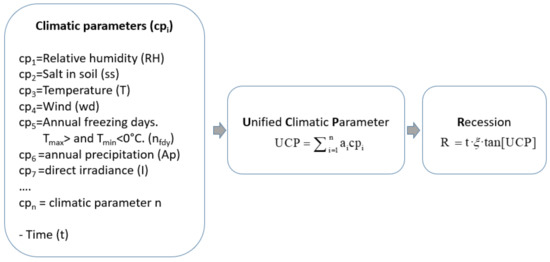
Figure 1.
Flow chart showing the method proposed.
For convenience, the recession of the brick façade (R) is formulated by using the tangent function Equation (2). This formulation was inspired by the equation of the helicoid surface.
The tangent function (tan[x]) has been chosen because it is almost linear for values of x in the interval [−0.5, 0.5]. ξ is a variable that connects the recession measured using photogrammetry with tan(UCP) for a constant period of time, t. The number of unknowns in Equation (2) is n + 1, with n as the number of climatic parameters considered (cpi), and ξ as the additional unknown.
The UCP can be obtained from literature, from laboratory data, or from both. However, for the calculation of ξ, observation of the deteriorated heritage building being studied is needed.
Case Study: Santa Maria dei Servi in Venice, Italy
In the case of Santa Maria dei Servi church in Venice, the deterioration of the main façade of the building was studied by comparing the western (external) and eastern (originally internal) walls. This façade is characterized by the range of exposure times it has undergone since the construction of the church took place during the 14th and 15th centuries (work started in 1330). The roof was destroyed at the beginning of the 19th century (specifically, in 1815), and this also exposed the internal wall to environmental agents. Therefore, it is a perfect case study for assessing the damage evolution of bricks as a function of time and different cardinal orientations (e.g., bricks with western exposure vs bricks with eastern exposure).
The façade was studied using photogrammetry, and the resulting point cloud was managed using CloudCompare software [13]. In order to determine the deterioration patterns of the bricks, cross sections of the façades were extracted from the cloud, and a 1-m spacing step was adopted. In this way, 24 sections for the western façade and 16 for the eastern façade were acquired. Descriptive coordinates of a selection of representative profiles were exported as coordinates and plotted in cumulative scatter diagrams (Figure 2).
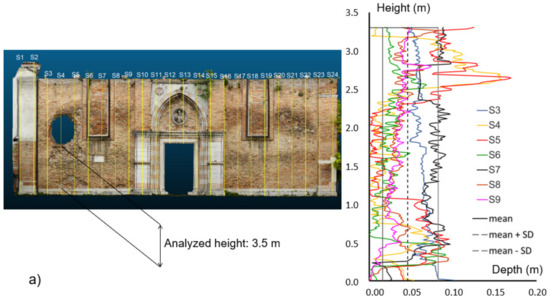
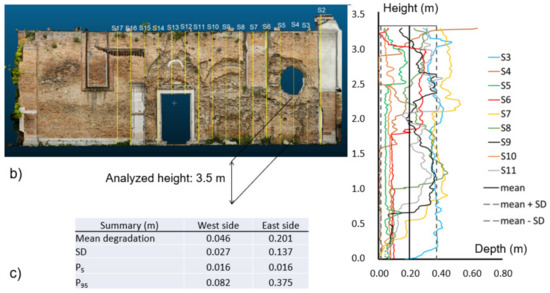
Figure 2.
Recession patterns of (a) the external (western) side of the frontal façade and (b) the internal (eastern) side of the façade of Santa Maria di Servi church in Venice, and (c) summary.
Buildings in Venice are almost entirely constructed of brick, which has a porous, fragile structure which is vulnerable to the devastating effects of marine salts. Water-soluble salts contained inside the bricks have a serious decaying effect on masonry structures and can be a major source of mechanical damage. The mortars and plasters used in the construction process can worsen these effects. Moreover, during the winter, air temperatures often drop below 0 °C and freeze–thaw cycles can take place, adding an additional degrading effect to that of salt crystallization, and this can increase wall damage.
Several studies are available in the literature that connect climatic parameters and material deterioration. In particular, for bricks [14,15], some deterioration processes, such as freeze–thaw action for different levels of relative humidity and salt-crystallization, have been studied. Figure 3, taken from Yue et al. [15] shows an example of mass loss rate as a function of the number of freeze–thaw cycles and relative humidity. Coletti et al. [14] show an example of mass loss rate for salt-crystallization cycles for different types of bricks.

Figure 3.
Mass loss rate for bricks. Mass loss rate (%) as function of the number of freeze–thaw cycles (N) and relative humidity (ω). Adapted from [15].
Figure 3 [15] shows the mass loss rate (%) as a function of the number of freeze–thaw cycles (N) and humidity (ω) for a particular type of brick. The authors of these studies [15] tested 50 × 50 × 50 mm bricks, so the loss in volume is related with the recession of surface (R) as:
The relative influence of humidity and freeze–thaw cycles is obtained from Figure 3. Since the humidity ranges between 40 and 80% in ambient conditions, the relative influence is approximated linearly using the records for 50 freeze-thaw cycles and for 60% and 80% humidity; see Figure 3:
Additionally, salt-crystallization cycles are another major deterioration phenomenon, as shown in [14] from a study on 50 × 50 × 50 mm bricks. The number of peak sun hours per day is chosen as a valid climatic parameter for the quantification of deterioration caused by salt crystallization in different orientations of a specific site.
As previously mentioned, the UCP is a weighted linear combination of the climatic parameters that affect the deterioration considered, in this case the recession of a brick façade.
For the study of the bricks used at Santa Maria dei Servi church, three climatic parameters are used: number of days per year with temperatures below zero (nfdy), relative humidity (RH) and peak sun hours of per day (npsh). The weighting coefficients obtained in Equation (4) are considered to be valid for nfdy and RH. A more comprehensive approximation could have been made considering other parameters such as the wind effect, but there were not enough records available.
Regarding the recession of the brick façade, a constant deterioration in the thickness along the height of the façade has been considered which is in agreement with the shape of the deterioration on the façades (Figure 2).
The façade recession (in mm) is formulated from Equation (2) as:
where the peak sun hours per day (npsh) was estimated using [16], the relative humidity (RH) and the mean number of days per year with temperatures below zero (nfdy) were processed from the weather station located in the central area of Venice, at Palazzo Cavalli, in a period that ranged from 2002 to 2021 (refer to Table 1).

Table 1.
Climate parameters considered between 2002–2021 from the weather station located at the Palazzo Cavalli, in Venice.
Table 1 reports the average and total values calculated from data for each year provided by the website of the Municipality of Venice [17] and the total average value calculated for the period 2002–2021.
From photogrammetric data, see Figure 2, the western side of the façade has an average recession of 0.046 m, so Equation (5) is particularized as:
Note that Equation (6) has two unknowns: the salt-crystallization weighting coefficient (a3) and ξ. Note that nfdy is known, as shown in Table 1.
The eastern side of the façade has altered greatly over time, and this makes it difficult to obtain a recession rate that is exclusively associated with climatic actions. As a result, the study focuses on the part of Section 3 (S3) located at a height between 5.5 m and 7.0 m above the ground (hereinafter, the upper part) on both sides of the wall, which does not seem to have been anthropically modified; see Figure 2 and Figure 4.
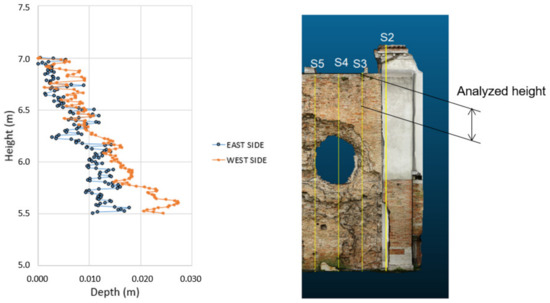
Figure 4.
Photogrammetric study of the eastern side of the façade of Santa Maria dei Servi church in Venice: on the left, the difference in the depth of deterioration from the eastern and the western sides of the main façade. On the right, the eastern side of the façade with the set of profiles from which S3 has been selected.
The upper part of both sides of Section 3 (S3) are compared to obtain a second equation of recession, Equation (7). The western side of the façade has been exposed to the elements since 1330 while the eastern side has only been exposed since 1815, when the roof of church was demolished. This fact was taken into account when carrying out this study. The eastern side of the façade has 1.81 peak sun hours per day, while the western façade has 1.49 h [16]. By assuming a constant recession rate and given that the difference between the depth of deterioration on both sides of the façade is 4.375 mm (Figure 4), it can be concluded that:
In the last twenty years, Venice had a mean relative humidity (RH) of 69.1% and 4 frost days per year (nfd). So, by solving Equations (6) and (7) for nfty = 4 and RH = 0.691, ξ = 0.0265 mm/year and a3 = 0.775.
Once the UCP had been obtained, the recession depth for Santa Maria dei Servi church as a function of time was given by:
As can be seen, the UCP is highly influenced by exposure to sun radiation. Equation (8) is plotted in Figure 5, which leads to the corresponding Deterioration Evolution Diagram (DED) in which the grey circles represent both sides of the façade of Santa Maria dei Servi church.
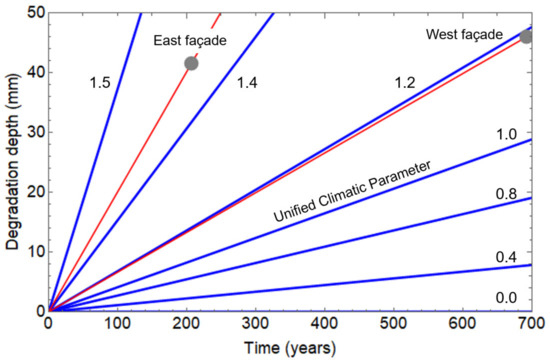
Figure 5.
Deterioration Evolution Diagram (DED) of the bricks depending on the exposure times of the façades and the Unified Climatic Parameter, which accounts for the different orientations of the two sides of the main façade of Santa Maria dei Servi church in Venice (grey circles), facing west and east, respectively.
Results show that even though the western side of the façade displays the highest level of loss of surface material, the deterioration rate on its eastern side is more significant when the different exposure times to environmental factors are considered in the UCP (RH, nfd and nfty).
The deterioration function proposed (Equation (2)) is formulated to maintain linearity so that damage can accumulate. Using the graph shown in Figure 5 (or Equation (2)), once the deterioration in each climatic scenario considered (with the corresponding duration) is calculated, the total deterioration can be obtained as the summation of all the individual deteriorations.
3. Conclusions
A novel methodology that connects climate conditions with the evolution of the recession of brick façades as a function of time is presented. The approach requires experimental laboratory information about the behavior of the bricks under environmental stressors in addition to measurements of deterioration patterns.
A single parameter, the Unified Climatic Parameter (UCP), which is a linear combination of the climatic parameters that affect a specific deterioration process of a building material, is defined. The deterioration patterns have been obtained by using 3D photogrammetry.
The methodology proposed allows deterioration rates under different climatic scenarios to be obtained, as well as the calculation of the total deterioration by adding the different scenarios.
Author Contributions
Conceptualization, C.M. and E.H.-M.; Data curation, S.D., C.C. and L.G.; Formal analysis, C.C., L.H.-G. and E.H.-M.; Funding acquisition, C.M. and E.H.-M.; Investigation, C.C., L.H.-G., and E.H.-M.; Methodology, C.C., S.D. and L.G.; Supervision, E.H.-M.; Writing—original draft, L.H.-G., S.D. and L.G.; Writing—review and editing, C.C., C.M. and E.H.-M. All authors have read and agreed to the published version of the manuscript.
Funding
This work is part of the HYPERION project (https://www.hyperion-project.eu/, accessed on 2 January 2023). HYPERION has received funding from the European Union Framework Programme for Research and Innovation (Horizon 2020) under grant agreement no. 821054. The content of this publication is the sole responsibility of the authors and does not necessarily reflect the opinion of the European Union.
Data Availability Statement
Not applicable.
Acknowledgments
The second author would like to acknowledge the financial support provided by the University of Granada from the program for collaborating undergraduate students. Authors acknowledge Stefano Castelli for its contribution in the research.
Conflicts of Interest
The authors declare no conflict of interest.
References
- Burns, G. Deterioration of our cultural heritage. Nature 1991, 352, 658–660. [Google Scholar] [CrossRef]
- Ghobadi, M.H.; Torabi-Kaveh, M. Assessing the potential for deterioration of limestones forming Taq-e Bostan monuments under freeze–thaw weathering and karst development. Environ. Earth Sci. 2014, 72, 5035–5047. [Google Scholar] [CrossRef]
- Lerma, J.L.; Cabrelles, M.; Portalés, C. Multitemporal thermal analysis to detect moisture on a building façade. Constr. Build. Mater. 2011, 25, 2190–2197. [Google Scholar] [CrossRef]
- Maravelaki, P.; Bertoncello, R.; Biscontin, G.; Battaglin, G.; Zendri, E.; Tondello, E. Investigations of the Surface Processes on Exposed Limestones. MRS Proc. 1992, 267, 943. [Google Scholar] [CrossRef]
- Salvini, S.; Bertoncello, R.; Coletti, C.; Germinario, L.; Maritan, L.; Massironi, M.; Pozzobon, R.; Mazzoli, C.; Salvini, S.; Bertoncello, R.; et al. Recession rate of carbonate rocks used in cultural heritage: Textural control assessed by accelerated ageing tests. J Cult Herit. 2022, 57, 154–164. [Google Scholar] [CrossRef]
- Bonazza, A.; Messina, P.; Sabbioni, C.; Grossi, C.M.; Brimblecombe, P. Mapping the impact of climate change on surface recession of carbonate buildings in Europe. Sci. Total Environ. 2009, 407, 2039–2050. [Google Scholar] [CrossRef] [PubMed]
- Sabbioni, C.; Brimblecombe, P.; Cassar, M. Atlas of Climate Change Impact on European Cultural Heritage; Anthem Press: London, UK, 2010; ISBN 978927909800-0. [Google Scholar]
- Sardella, A.; Palazzi, E.; von Hardenberg, J.; Del Grande, C.; De Nuntiis, P.D.; Sabbioni, C.; Bonazza, A. Risk mapping for the sustainable protection of cultural heritage in extreme changing environments. Atmosphere 2020, 11, 700. [Google Scholar] [CrossRef]
- Bonazza, A.; Sardella, A.; Kaiser, A.; Cacciotti, R.; De Nuntiis, P.; Hanus, C.; Maxwell, I.; Drdácký, T.; Drdácký, M. Safeguarding cultural heritage from climate change related hydrometeorological hazards in Central Europe. Int. J. Disaster Risk Reduct. 2021, 63, 102455. [Google Scholar] [CrossRef]
- Cacciotti, R.; Kaiser, A.; Sardella, A.; De Nuntiis, P.; Drdácký, M.; Hanus, C.; Bonazza, A. Climate change-induced disasters and cultural heritage: Optimizing management strategies in Central Europe. Clim. Risk Manag. 2021, 32, 100301. [Google Scholar] [CrossRef]
- Germinario, L.; Coletti, C.; Girardi, G.; Maritan, L.; Praticelli, N.; Sassi, R.; Solstad, J.; Mazzoli, C. Microclimate and Weathering in Cultural Heritage: Design of a Monitoring Apparatus for Field Exposure Tests. Heritage 2022, 5, 3211–3219. [Google Scholar] [CrossRef]
- Coletti, C.; Cultrone, G.; Maritan, L.; Mazzoli, C. Combined multi-analytical approach for study of pore system in bricks: How much porosity is there? Mater. Charact. 2016, 121, 82–92. [Google Scholar] [CrossRef]
- Jalón, M.L.; Chiachío, J.; Gil-Martín, L.M.; Hernández-Montes, E. Probabilistic identification of surface recession patterns in heritage buildings based on digital photogrammetry. J. Build. Eng. 2020, 34, 101922. [Google Scholar] [CrossRef]
- Coletti, C.; Cultrone, G.; Maritan, L.; Mazzoli, C. How to face the new industrial challenge of compatible, sustainable brick production: Study of various types of commercially available bricks. Appl. Clay Sci. 2016, 124–125, 219–226. [Google Scholar] [CrossRef]
- Yue, J.; Ma, C.; Zhao, L.; Kong, Q.; Xu, X.; Wang, Z.; Chen, Y. Study on Deterioration of Gray Brick with Different Moisture Contents under Freeze – Thaw Environment. Materials 2022, 15, 1819. [Google Scholar] [CrossRef] [PubMed]
- Available online: https://footprinthero.com/peak-sun-hours-calculator (accessed on 2 January 2023).
- Municipality of Venice. Available online: https://www.comune.venezia.it/ (accessed on 2 January 2023).
Disclaimer/Publisher’s Note: The statements, opinions and data contained in all publications are solely those of the individual author(s) and contributor(s) and not of MDPI and/or the editor(s). MDPI and/or the editor(s) disclaim responsibility for any injury to people or property resulting from any ideas, methods, instructions or products referred to in the content. |
© 2023 by the authors. Licensee MDPI, Basel, Switzerland. This article is an open access article distributed under the terms and conditions of the Creative Commons Attribution (CC BY) license (https://creativecommons.org/licenses/by/4.0/).